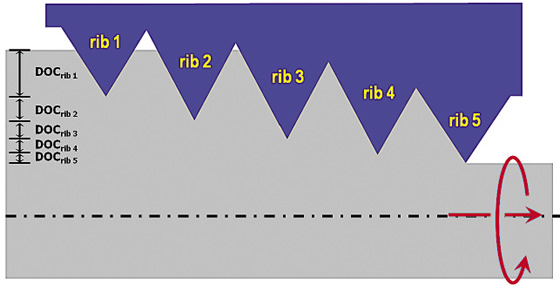Dear Doc: I cylindrical-grind threads into hardened steel using multiple-rib, vitrified-bond, aluminum-oxide wheels and am getting breakdown of the thread root. I increased the number of passes from four to six to even eight, but it doesn’t seem to help. Why?
The Doc Replies: Think of multiple-rib grinding wheels as a series of, say, five different wheels, each with a slightly larger diameter than the previous wheel. Let’s say you’re taking a 1mm DOC. Depending on the geometry, the fifth rib grinds a 0.025mm DOC, the fourth rib a 0.050mm DOC, the third rib a 0.100mm DOC, the second rib a 0.200mm DOC and the first rib grinds the remainder, or 0.625mm (1.000mm - 0.025mm - 0.050mm - 0.100mm - 0.200mm = 0.625mm). That fifth, final rib is going to take 0.025mm regardless of the total DOC, because that’s the material remaining after the fourth rib grinds its 0.050mm DOC. If the total DOC is 0.025mm, only the fifth, final rib will remove material.

In this example for a 1mm DOC, the fifth and final rib grinds a 0.025mm DOC, the fourth rib a 0.050mm DOC, the third rib a 0.100mm DOC, the second rib a 0.200mm DOC and the first rib grinds a 0.625mm DOC. Image courtesy J. Badger.
Let’s say you decide to divide that one 1mm pass into five 0.200mm passes. That fifth rib is still going to take 0.025mm each pass. Sure, the first rib gets a complete break, but the fifth rib takes a beating, because it’s now doing five 0.025mm passes instead of one. When taking multiple passes, if the DOC on a pass is less than 0.375mm for this example (ribs 1 + 2 + 3 + 4 = 0.025mm + 0.050mm + 0.100mm + 0.200mm = 0.375mm), then the first rib is not removing any material per pass and the second rib is only removing 0.025mm. Because the fifth rib is the one generating the final form, you’re going to lose form more quickly when taking multiple passes.
There’s a rough calculation for estimating the relative beating that final rib is taking: final rib beating = number of passes × workpiece rpm ÷ wheel speed. To give the final rib a break (and to better hold form), decrease the number of passes, making the first rib do more of the work, and slow the workpiece rpm or increase the wheel speed. Of course, you don’t want the first rib to break down too much either, because then subsequent ribs will start to break down as well. Also, these will all typically increase heat generation and the risk of burn. But if your biggest issue is holding form, this will help.
If you want to get clever, develop a spreadsheet using the DOC for each rib, workpiece rpm and wheel speed, and calculate a relative “aggressiveness number” for each rib in each pass. You can then try to distribute the load and the material-removal rates more evenly. CTE
Dr. Jeffrey Badger is an independent grinding consultant. The Doc will be giving his High Intensity Grinding Course in New York on Nov. 4-6, hosted by Lieber & Solow. Website: www.TheGrindingDoc.com.
Related Glossary Terms
- grinding
grinding
Machining operation in which material is removed from the workpiece by a powered abrasive wheel, stone, belt, paste, sheet, compound, slurry, etc. Takes various forms: surface grinding (creates flat and/or squared surfaces); cylindrical grinding (for external cylindrical and tapered shapes, fillets, undercuts, etc.); centerless grinding; chamfering; thread and form grinding; tool and cutter grinding; offhand grinding; lapping and polishing (grinding with extremely fine grits to create ultrasmooth surfaces); honing; and disc grinding.







